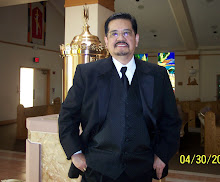 Left, St. James' Cathedral, Santiago de Compostela
Left, St. James' Cathedral, Santiago de CompostelaBelow, Nuestra Senora del Pilar, Zaragoza

If one is doing the Visita Iglesia, he is expected to visit at least seven churches and up to a maximum of fourteen. What is Visita Iglesia?
Visita Iglesia is another old Lenten tradition in the Philippines. It takes place on the Maundy Thursday of the Semana Santa (Holy Week). As tradition has it, Visita Iglesia commences at sunset and ends in the early hours of Good Friday.
In the area in Mandaluyong where I grew up, there are two churches: the Roman Catholic Church of San Felipe Neri, and the Philippine Independent Church (Aglipayan). These two churches shared somewhat similar religious practises and rituals, and so during the Semana Santa, such similarities gave rise to minor discomfort among the many residents who lived within the two parishes. Here, I am talking about the scheduling of the procession, and no other.
So as not to create a traffic disaster and an issue, which we kids, called "harangan" (cutting of, as in bad driving) the two churches decided to hold Holy Week processions on two different days. One, I think the Catholics, had theirs on a Wednesday and the Aglipays, on a Thursday. But , of course, on Good Friday, both churches held their respective procession on the same evening.
We kids considered these two processions as a competition. It was normal for us to hear murmurs among the crowd - those bystanders - giving their two-cent worth opinion as to which among the two churches had the better "carosas" or statues.
A Lola (grand aunt) of ours had a Santa Veronica in these processions and a maternal grand uncle owned the Magdalena. So a few hours before dusk, the people living in our street would be enthralled by the passing of these two saints, clad in their best colorful outfit and with hair as silky as the moon and as yellow as the sun - riding high on their ornate "carosas" and leaving behind the scent of sampaguita, ylang ylang and champaca.
Once the procession left the church, we scrambled and picked which saint to follow. Me and my siblings always followed Veronica; but sometimes, we trailed also Magdalena, especially if the scent of the "karburo," the chemical which powered the lights of Veronica, started to bother our nostrils.
For us, the Visita Iglesia started after the procession had ended. Next to our church, we would visit the Santa Ana Church, and sometimes, we went as far as the San Miguel Church which is located near the Malacanang Palace.
Sadly, the practise of Visita Iglesia is not observed in North America. Here in Canada, the Maundy Thursday church service is celebrated in the evening, unlike in the Philippines where it takes place in the morning. Thus, our Maundy Thursday service is held at seven and as it is celebrated throughout the whole Christendom, consists of the commemoration of the Lord's Last Supper.
And unlike also in the Philippines, we start our long Easter weekend, not on Holy Wednesday, but on Good Friday. Offices are closed on Good Friday and for most, returning to work is on the following Tuesday.
This post was originally posted in my other blog: www.luckycanary.blogspot.com






